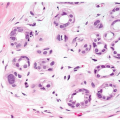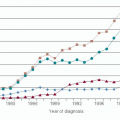Physical Examination of the Breast
Monica Morrow
Obtaining a careful history is the initial step in a breast examination. Regardless of the presenting complaint, baseline information regarding menstrual status and breast cancer risk factors should be obtained. The basic elements of a breast history are listed in Table 3-1. In premenopausal women, knowing the date of the last menstrual period and the regularity of the cycle is useful in evaluating breast nodularity, pain, and cysts. Postmenopausal women should be questioned about use of hormone replacement therapy, given that many benign breast problems are uncommon after menopause in the absence of exogenous hormones. Specific information about the patient’s presenting complaint is then elicited. A breast lump is most often the clinical breast problem that causes women to seek treatment, and remains the most common presentation of breast carcinoma. Haagensen (1) observed that 65% of 2,198 breast cancer cases identified before the use of screening mammography presented as breast masses. Breast pain, a change in the size and shape of the breast, nipple discharge, and changes in the appearance of the skin are infrequent symptoms of carcinoma. The evaluation and management of these conditions are described in Chapters 5, 6, and 7. In general, the duration of symptoms, their persistence over time, and their fluctuation with the menstrual cycle should be assessed.
TECHNIQUE OF BREAST EXAMINATION
A woman must be disrobed from the waist up for a complete breast examination. Although attention to modesty is appropriate, and a gown or drape should be provided, inspection is an important part of the examination, and subtle abnormalities are best appreciated by comparing the appearance of both breasts. Breast examination should be done with the patient in both the sitting and supine positions, and care should be taken at all times to be gentle. The steps of a breast examination are illustrated in Figure 3-1.
The breasts should initially be inspected while the patient is in the sitting position with the arms relaxed (Fig. 3-1A). A comparison of breast size and shape should be made. If a size discrepancy is noted, its chronicity should be determined. Many women’s breasts are not identical in size, and the finding of small size discrepancies is rarely a sign of malignancy. Differences in breast size that are of recent onset or progressive in nature, however, may be owing to both benign and malignant tumors, and require further evaluation (Fig. 3-2). Alterations in breast shape, in the absence of previous surgery, are of more concern. Superficially located tumors can cause bulges in the breast contour or retraction of the overlying skin. The skin retraction seen with superficial tumors may be caused by direct extension of tumor or fibrosis. Tumors deep within the substance of the breast that involve the fibrous septa (Cooper’s ligaments) can also cause retraction. Retraction is not itself a prognostic factor except when caused by the direct extension of tumor into the skin and, for this reason, it is not a part of the clinical staging of breast cancer (2). Although retraction is often a sign of malignancy, benign lesions of the breast, such as granular cell tumors (3) and fat necrosis (4), also cause retraction. Other benign causes of retraction include surgical biopsy and thrombophlebitis of the thoracoepigastric vein (Mondor’s disease) (5) (Fig. 3-3).
Stay updated, free articles. Join our Telegram channel

Full access? Get Clinical Tree






